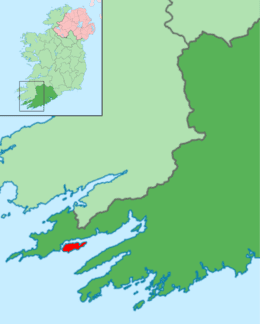Width 2.9 km (1.8 mi) Highest point Knockanallig Elevation 270 m Island group British Isles | Length 10.1 km (6.28 mi) Highest elevation 270 m (890 ft) Area 17.68 km² | |
 | ||
Bere island west cork ireland what a trip
Bere Island Irish: Oiléan Béarra, meaning "bear island", although officially called An tOileán Mór meaning "the big island") is an island off the Beara Peninsula in County Cork Ireland. It is roughly 10 km x 3 km in dimension, with an area of 17.68 km², and, as of 2012, has a population of between 210 and 220 people.
Contents
- Bere island west cork ireland what a trip
- Map of Bere Island Co Cork Ireland
- A quick drive around bere island cork ireland
- Geography
- Subdivisions
- Demographics
- History
- Archaeology
- References
Map of Bere Island, Co. Cork, Ireland
Legend says that the island was named by a 2nd-century king of Munster, Mogh Nuadat, in honour of his wife, Beara, the daughter of Heber Mór, King of Castile.
A quick drive around bere island cork ireland
Geography
The island is located between Berehaven Harbour and Bantry Bay in the western part of County Cork, about 1.5 km off the port of Castletownbere. It belongs to the civil parish of Killaconenagh (Cill Eacha Naoineach) within the Barony of Bear (Béarra). It is served by two ferries, which can carry light vehicles. The highest point on the island is Knockanallig, at a height of 270 metres. The main harbour is Lawrence Cove, near the main village of Rerrin (Raerainn), toward the eastern end of the island. The church and its graveyard are located in Ballinakilla.
Subdivisions
Ten of then 75 townlands of the civil parish of Killaconenagh are located on the island:
Demographics
As of 2012, the population was approximately 200, but the past population was significantly higher. At the time of the 1841 census the population was 2,122. However, by the 1851 census the population had decreased to 1,454 due to the Great Famine. The population decline continued in line with the national trend for emigration throughout the 19th and 20th centuries. Unlike many of the other islands off the Irish coast, the inhabitants of Bere Island are native speakers of English. Irish ceased to be the spoken language of the majority of the native islanders between 1880 and 1885.
History
Early traces of human occupation include megalithic tombs and standing stones. The island was the property of the O'Sullivan Bere clan and remained so until the power of the Gaelic chieftains was finally broken in 1602. This period also saw the first military interest in the island when Sir George Carew ordered a road to be built across the island to transport the pro-English forces to the Siege of Dunboy.
In December 1796, a French fleet entered Bantry Bay and Berehaven Harbour, led by General Hoche under the direction of Wolfe Tone, the leader of the United Irishmen. The French longboat which landed in Bere Island is now in the National Museum of Ireland. Adverse winds prevented the main force landing and eventually caused the fleet to disperse and return home. In August 1798, there was a further invasion attempt, at Killala in County Mayo, following the Irish Rebellion of that year. The result of these events was that the British authorities reviewed their defensive plans and in 1803, with the country once again at war with France, Lieutenant-Colonel William Twiss was sent to Ireland to draw up a plan of defence for the country. As part of this review he was directed to examine what security could be given to Bantry Bay.
Rear-Admiral Sir Robert Calder, who commanded the naval squadron based in Castletownbere Port wrote to the Rt. Hon. William Wickham on 22 December 1803 to request protection for his victualers and store ships, which were to be based at the Berehaven anchorage to supply his squadron. Wickham agreed that protection for the ships was necessary and instructed William Cathcart, 1st Earl Cathcart to order his engineers to carry out works to build Martello Towers on the island. The Bere Island towers were reported as ready on 2 February 1805 and were therefore probably among the earliest Martello Towers to be completed in Ireland. The four, all circular in shape and built of rubble masonry, were sited to defend the anchorage between the mainland and the small harbour of Lawrence Cove on Bere Island. In addition to the Martello Towers, a signal tower, a barracks for 2 officers and 150 men, a quay and storehouses were also constructed. After the end of the Napoleonic Wars there followed a period of military stagnation. This ended in 1898 when the British military raised a compulsory purchase order on large areas of the island in order to construct additional fortifications in order to protect the British Fleet at anchor in Berehaven Harbour.
During the Anglo-Irish War some Irish republicans were interned on Bere Island, including Canon William Kennedy, head (from 1919-1932) of St Flannan's College, Ennis. In 1922, under the terms of the Anglo-Irish Treaty that followed the Irish War of Independence, the British withdrew from most of Ireland but three deep water Treaty Ports, at Berehaven, Queenstown (renamed Cobh), and Lough Swilly, were retained as sovereign bases until 1938.
Work started on providing mains electricity to the island via submarine cable in July 1957 and was completed in April 1958
